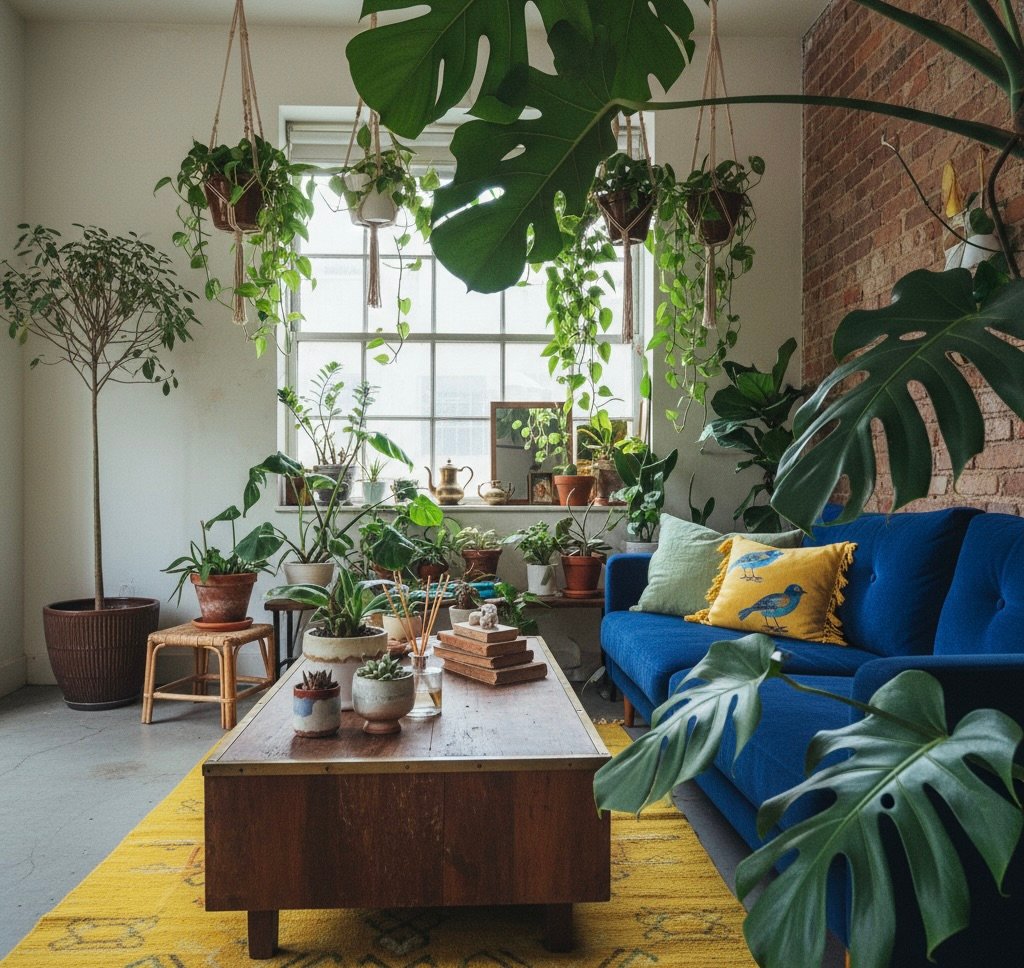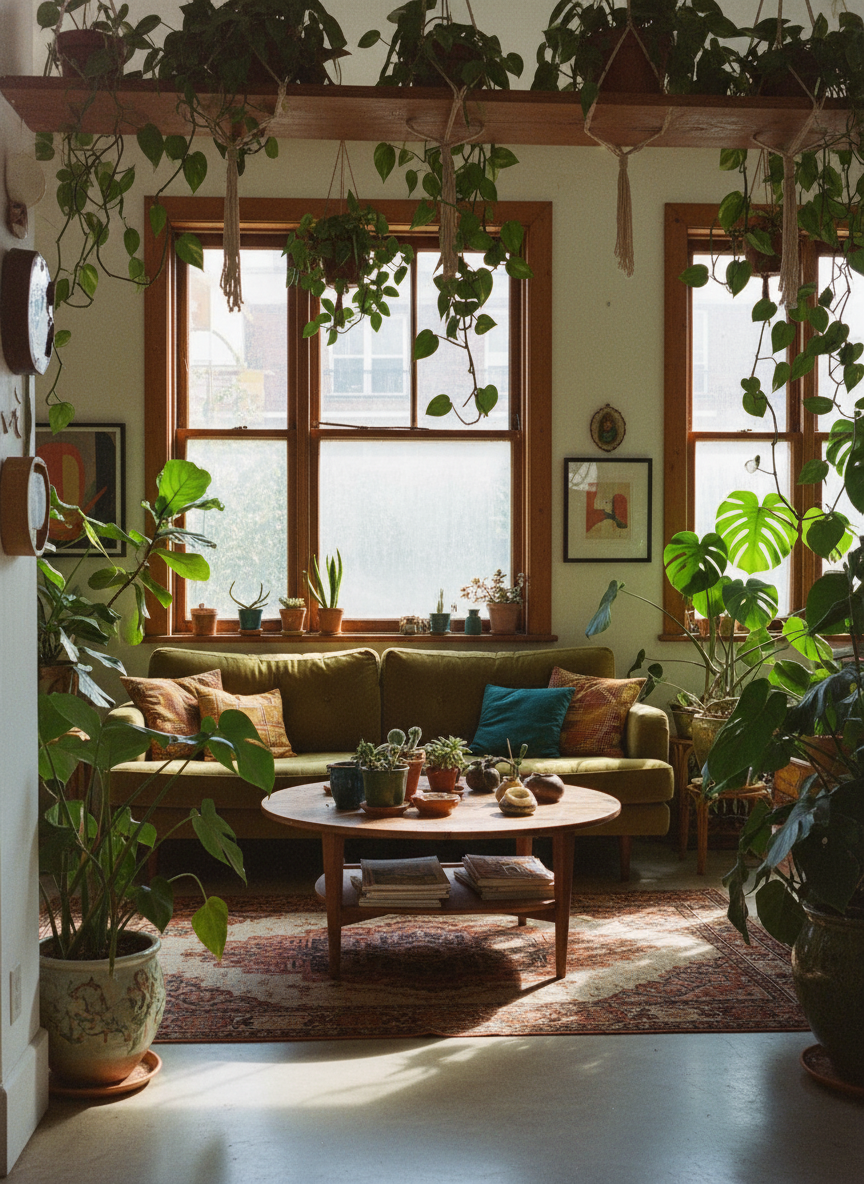
The Biophilic Design Trend 2025: How to Bring Nature Into Your Home
If you’ve ever stepped into a space that immediately makes you feel calmer, lighter, and somehow more alive, you’ve probably experienced biophilic design — even if you didn’t realize it. It’s that almost magical balance between beauty and nature that transforms a house into a home that breathes.
Lately, I’ve been seeing this trend everywhere — in interiors magazines, Pinterest boards, and the way people talk about creating peaceful spaces at home. And honestly, it’s not hard to see why. The world feels busier than ever, our days are filled with screens and noise, and so many of us are craving something slower, softer, and more real.
That’s where biophilic design comes in. It’s not about adding a few trendy houseplants to your living room — though that’s a great start. It’s about creating a home that reconnects you to nature through light, texture, materials, and atmosphere. A home that makes you exhale the second you walk through the door.

What Biophilic Design Really Means
The word biophilia comes from Greek — bio meaning life, and philia meaning love. It literally means a “love of life,” and that’s exactly what this design philosophy is built on. Humans are wired to connect with nature, but so much of modern living pulls us away from it.
Biophilic design bridges that gap. It’s about designing spaces that remind us of the outdoors — not in a kitschy way, but through natural light, greenery, organic materials, and a sense of flow that mirrors the calm rhythm of nature itself.
When done well, it doesn’t just make a room look beautiful — it actually changes how you feel in that space. There’s science behind it too: studies show that being surrounded by natural elements can reduce stress, improve focus, and even help you sleep better.
Whenever I start thinking about biophilic design, I always start with light. It’s the most powerful — and most underrated — design tool. Natural light has this incredible ability to lift a space and transform your mood instantly.
In my own home, I try to keep my windows as open and airy as possible. I swapped heavy curtains for soft linen drapes that let sunlight filter through gently, and I keep mirrors opposite the windows to bounce the light around. Even small changes like moving a chair closer to a window or keeping window ledges clear make a difference.
When sunlight floods in, it creates shadows, warmth, and movement — all the things that make a space feel alive. Artificial light can’t quite capture that same magic.
It’s impossible to talk about biophilic design without talking about plants — the living, breathing heart of any nature-inspired space. Over time, I’ve built up my own little collection of green companions: a tall monstera in the corner of my living room, a peace lily that’s somehow survived every season, and a few trailing vines that have started claiming my shelves as their own.
What I love most is how each plant adds personality. A big leafy statement plant gives the room structure and drama. Smaller, cascading varieties soften hard edges and bring warmth to minimal spaces. Even a single plant on a desk can change the entire energy of a room.
If you don’t have the best track record with houseplants, don’t worry — biophilic design isn’t about perfection. Choose low-maintenance ones like snake plants, ZZ plants, or rubber trees. They thrive in most conditions and barely need attention. It’s less about having a jungle and more about letting something living share your space.
Another key part of this trend — and one I’ve completely fallen in love with — is texture. There’s something grounding about materials that feel real: unpolished wood, woven baskets, ceramic pots, linen cushions, and stone surfaces.
I’ve started swapping out synthetic or overly glossy decor for natural, tactile pieces. A raw wooden stool instead of plastic. A woven jute rug that adds warmth to a neutral room. Even small details like clay planters or a handmade mug on your coffee table can subtly shift a space’s energy.
These textures remind us of nature’s imperfection — and that’s the point. They don’t need to be flawless; they just need to feel authentic.

Sounds, Scents, and Small Sensory Details
Biophilic design is about engaging all your senses, not just your sight. I learned this when I added a small tabletop fountain to my living room — I didn’t expect much, but the soft sound of water trickling became this quiet, meditative background that instantly relaxed me.
Even when I’m working, I’ll play a nature playlist — rain, forest birds, ocean waves. It’s a simple way to soften the edges of a busy day.
Scent plays a huge role too. Essential oils like eucalyptus, cedarwood, or lavender can make a home feel fresher and more natural without being overpowering. A candle or diffuser that smells like the outdoors helps create that full sensory connection.
There’s also a feeling of flow in biophilic spaces that I think is often overlooked. It’s not about filling every corner — it’s about allowing room for movement, breathing space, and balance.
I’ve started being more intentional with how I arrange my furniture. I keep walkways clear, angle chairs toward the window, and avoid clutter that blocks light or energy. The result is a home that feels easy to move through — calm, not crowded.
Even if you don’t have sweeping garden views, you can mimic that openness. Hang a landscape print, use natural color palettes like sage, sand, clay, and soft white, or add small organic accents — a bowl of shells, a driftwood piece, dried flowers in a vase. These simple touches quietly echo nature.
What I love most about biophilic design is that it’s emotional. It’s not just about creating something “pretty”; it’s about creating a space that supports your wellbeing. After a long day, walking into a room filled with soft light, greenery, and natural textures feels like taking a deep breath.
There’s a warmth and authenticity to it that goes beyond any trend. It reminds us that home isn’t supposed to feel sterile or perfect — it’s meant to be alive, evolving, and filled with energy.
When I sit by the window with the afternoon sun on my plants and the sound of water in the background, I feel grounded — like my space is part of the natural world, not separate from it. And that’s a feeling I think so many of us are chasing right now.
At its core, biophilic design is a return to something simple — the desire to feel connected to the earth again. It’s not about having the biggest plant collection or spending a fortune on wooden furniture. It’s about finding harmony between your home and the natural rhythms that make you feel at peace.
When I started leaning into biophilic design, I quickly realised that the details make all the difference — the textures, shapes, and materials that tie everything together. I’ve slowly been collecting pieces that bring that organic warmth into my home, and honestly, they’ve completely changed how my space feels.
Here are a few of my current favourites (some links are affiliate, meaning I may earn a small commission at no extra cost to you):
- Minimalist Nordic Ceramic Vase: https://amzn.to/4qWHR70
- Large Ceramic Rustic Vase: https://amzn.to/49KjXp2
- Reversible Glass Flower Vase and Bud Vase: https://amzn.to/4nKwxI9
- Clear Blue Bubble Glass Vase: https://amzn.to/3XnxPht
- Farmhouse Rustic Terracotta Vase: https://amzn.to/3WRyFDa
- Wabi Sabi Rustic Vintage Vase: https://amzn.to/4p9YfiU
- Vintage Flower Vase: https://amzn.to/4qX1r2K
- Round Wide-Mouth Farmhouse Vase: https://amzn.to/3WNPgHY
Start small. Open your windows more often. Let the light in. Add a plant that makes you smile every morning. Layer your space with textures that remind you of nature’s imperfections. Over time, you’ll notice your home start to feel different — calmer, more balanced, and alive in a way that can’t quite be explained.
Because in the end, biophilic design isn’t really about design at all. It’s about remembering that we are part of nature — and that when we bring those elements into our homes, we’re really just bringing ourselves back home, too.
